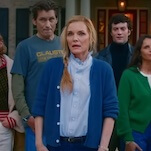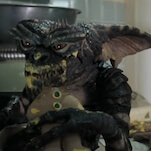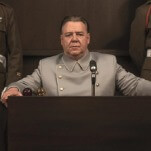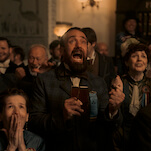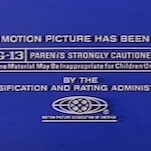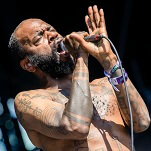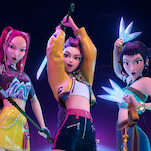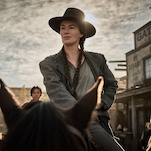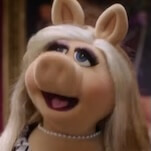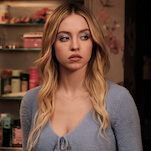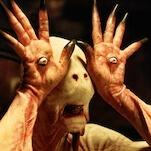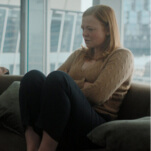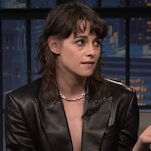(Warning: spoilers for The Sandman: Overture #1.)
Oliver Sava: Stories never really end, do they? Even after the final word on the page or the last shot on screen, stories live on in the imagination of the audience and, in more recent times, the limbo where narratives ferment until they’re ready for prequels and sequels. When Neil Gaiman ended The Sandman in 1996, he emphasized the idea that these characters and this world would live on after the end of the series, and the nature of mainstream comic books ensured that Gaiman’s concepts would stick around for a while. Understanding the appeal of anything Sandman related, Vertigo released The Dreaming ongoing series along with a slew of miniseries spotlighting characters like The Corinthian, The Dead Boy Detectives, Thessaly the witch, and Egyptian cat-goddess Bast. Gaiman himself returned to Dream and his siblings with the short-story collection Endless Nights and illustrated prose novel The Dream Hunters with Yoshitaka Amano (later adapted into a comic-book miniseries with P. Craig Russell).
To celebrate the 25th anniversary of his seminal series, Gaiman launches the six-issue prequel The Sandman: Overture with acclaimed artist J.H. Williams III, detailing the events that led to Morpheus’ capture at the start of The Sandman #1. Throw in colorist Dave Stewart and letterer Todd Klein, two virtuosos of their fields, and it’s one of the best creative teams assembled in recent memory. Gaiman’s recent comics for Marvel, 1602 and Eternals, were less than impressive, and while the art was lovely, the writing became very tiresome in Williams’ Batwoman, so it’s nice to see them on a project that utilizes their full potential. Gaiman understands the tone of The Sandman better than anyone, and Williams realizes that ethereal gothic atmosphere through his dramatic page design and impeccably detailed rendering.
A writer with no qualms about experimenting with the medium, Gaiman finds an ideal collaborator in Williams, a master of unconventional layouts and varied linework that pulls influence from a huge range of creators in both the comic-book and fine-art worlds. Those myriad influences all get a chance to come through in this first issue, which sees Williams switching styles for different scenes before going wild with the four-page gatefold spread that ends the issue. Going into Overture, I’m most excited about seeing how working with Gaiman will push Williams creatively; he grew dramatically after working with writers like Alan Moore, Grant Morrison, and Greg Rucka, and spending six issues in the fantastic, unpredictable universe of The Sandman is the perfect opportunity for the artist to continue sharpening his craft.
After spending considerable time with Morpheus and company for Back Issues, I was sure that I needed a break from The Dreaming, but damn did it feel nice to be back in this environment. Gaiman has such a strong handle on the voices of these characters that I can’t help but smile when The Corinthian preys on an office clerk oblivious of his horrifying fate, or when Merv Pumpkinhead recounts a conversation with a dreaming Sigmund Freud about the deeper meanings behind the phallic cigar in his moist, hollowed-out pumpkin skull. A grin probably isn’t the appropriate reaction for what is essentially a fantasy horror series, but the immediate feeling I get while reading Overture #1 is delight. It’s not clear how essential this story is going to be, but unlike the Before Watchmen prequels, there’s nothing that makes this book feel like a gratuitous cash-in on thepopularity of the source material. What are your feelings about this first chapter, Jason? Specifically, do you think Gaiman’s time away from this setting has hurt or helped his writing?
Jason Heller: Oliver, you know how much I hate playing the role of “the old man who was there, way back in the day” in our Crosstalk dialogues (okay, I actually love it), but I do feel obliged to mention that I started reading Gaiman’s Sandman when the first issue came out in 1989. So much hyperbole has been spilled about the series since then, it’s always good to remember exactly how mind-blowing this book really was when it first appeared. It was just so fucking dark. And before “dark” became comic-book shorthand for slapping a black costume and a scowl on an established character, Sandman evoked the ink-on-your-fingers mystique of ’70s monster comics, of which I’m also a huge fan, as well as the whole goth vibe that was definitely up my alley when I was a Bauhaus-obsessed teenager in ’89.
That’s not to say there was nothing like it at the time. I’d already read Epic series like Blood: A Tale and Moonshadow (the latter featuring future Sandman artist Jon J. Muth), Alan Moore’s Swamp Thing, and especially Gaiman’s and Dave McKean’s Black Orchid—which cracked open the door for Sandman, and, by extension, the collective aesthetic that culminated in the launch of Vertigo in 1993. But Sandman was different. It was an ongoing series, and it featured a character that could only nominally be considered a revamp; unlike Moore’s Swamp Thing, Gaiman’s Sandman didn’t look remotely like the characters of the same name that preceded him. That alone felt kind of stunning back then—but it was the story inside, and its shadow-shrouded mystery, that made such an instant impression.
The art had a lot to do with that, and Sandman has been known for the quality of Gaiman’s collaborators. Scoring Williams for Overture was a coup (although I can only assume it didn’t take that much convincing), and he nails this first issue. Graceful yet teeming with detail, Williams’ visuals—including his off-kilter, organic layouts—are perfectly matched with Gaiman’s kaleidoscopic script. But I do think there are some limitations to this first installment of Overture. Like you, Oliver, I loved being in this universe again, and with a fresh tale. But there is zero suspense here, even though this prequel story has been waiting to be told for 25 years. We know how it ends, more or less, and that zaps some of the forward momentum of the narrative. Gaiman doesn’t do a lot to help that. Basically, he’s just waving his camera around, giving us anecdotal snapshots of where various members of The Endless are at this point in time—although the scenes with The Corinthian are the most gripping, rushed and perfunctory as they are. This is at the heart of my main (but mostly minor) beef with Overture #1: It’s too much of a setup. When the inciting payoff comes—yes, I’m talking about the sumptuous, four-page foldout—it feels completely unearned and shoehorned into the story. And the panel that acts as a segue into it is completely inert, making the transition feel more jarring than breathtaking.
[pagebreak]
As for a few of the fine details, I loved them. Morpheus manifesting as an alien flower felt like a gorgeous homage to Moore’s Swamp Thing. Destiny got all meta in a way that wasn’t cheap or cute (hard as it is to imagine Destiny being in a cheap, cute scene). That said, I did not enjoy Merv’s “a cigar is just a cigar” scene, which did seem too cute to me. It also felt kind of canned, even clichéd, much as random lines like “the pain that feels like birth” did. Has Gaiman learned a lot about writing Sandman during his time away? I’d say no (and not just because I’m iffy on his novels overall). He’s picking up exactly where he left off, moving down the checklist of what Sandman fans want in a prequel. And that’s fine. Like I said, I liked this issue overall, and I can’t wait to see where it goes—even if it just gives me an excuse to wander around with these characters, soaking up their atmosphere. So, Oliver, how did you feel about the quadruple-splash—how it was executed, and what it might portend? And what were some of the smaller details that caught your eye?
OS: Before diving into the art, I wanted to address one of your qualms about Gaiman’s treatment of my favorite Sandman character, Merv Pumpkinhead. Regarding Gaiman’s overly cute tendencies, they’ve never bothered me because they provide a nice point of contrast for when the stories inevitably venture into very dark territory. Merv has always been comic relief before anything else, and it’s important that Gaiman chose to throw him in for a humorous aside in the midst of all the dire happenings. It gives the reader a moment to relax in a lighter environment, which ultimately helps amplify the tension when that sense of comfort is broken.
I do agree that the lack of suspense diminishes some of the forward momentum, but that cliffhanger proves that I really have no idea what is coming over the course of the next five issues. As shoehorned as that final splash may be, I was completely floored by it. I love the way Williams draws characters in styles that reflects their personalities, and I especially enjoy when these various visual flavors collide in a single panel. This worked phenomenally well in his Batman story “The Black Glove” with Grant Morrison. Seeing all those variations of Dream drawn in the styles of Pablo Picasso, Gustav Klimt, Jack Kirby, Bruce Timm, and many more makes the page a wonderful game of “spot the influence,” and I cannot wait for next issue, when we see these characters and their varied visuals in motion. The amazing thing about Williams is how these influences go further than just the linework; he has such a comprehensive understanding of the art world that he’s able to not only mimic the rendering, but the storytelling. If he’s drawing a Kirby-esque character, expect big, bombastic poses that make everything appear larger than life. If he’s working in a Picasso or Klimt mode, he can push his artwork into more abstract, graphic territory. I can’t wait to see how that skill is applied now that we know part of this story is Dreamapalooza.
I can’t help but feel that any four-page splash is going to feel a bit gratuitous, but this issue’s gatefold works because it really captures the massive scope of this gathering. This is a unique moment in the life of an immortal who has seen plenty of significant events over time, and nothing says big like using four pages to convey a single image. In terms of smaller details, I don’t even know where to start. There’s the page where Morpheus is getting ready to confront the force that is mysteriously pulling at him, laid out with panels that spell out his name. The opening plant dream where the panels are broken up by a root system growing in reverse. The first Corinthian scene laid out as a double-page spread of a mouth, individual panels created by teeth. The sequence where a conversation between Destiny and Death unfolds on a page in the Book Of Destiny, which shows a glimpse of Gaiman’s script for the issue on the far left. That page spotlights just how adept Williams is with using visual elements to transition from one scene to the next; the belt that fastens the book drifts into the image on the next page, creating a literal connection between two separate scenes.
Those transitions are there to create an incredibly smooth reading experience, which is then interrupted by those pesky house ads Vertigo foolishly did not put at the very end of the issue. All the ads unfold over two pages, so I’m tempted to buy some double-sided tape to get rid of them for all the people I plan on giving this first issue to. Normally, I don’t find ads all that intrusive, but with art as engrossing as Williams’, it’s impossible not to get pulled out of the moment when you turn the page and instead of more story, there are two giant promos instead. I’m absorbed by the prose and the art of the opening sequence, but then I’m ripped out of that world by an interview and ad that have nothing to do with what I’m reading. This book is truly an event, and if Vertigo isn’t going to publish this without ads, the best it could do is put all in the promos in the back so that they don’t mess with the pacing. Jason, you read a lot of gloriously ad-free alternative comics, did you find the promos similarly distracting? And what visual moments stuck out to you most? While it’s exciting to see Gaiman return to this universe, my interest in Overture stems primarily from seeing what Williams is capable of in this environment.
JH: Point taken about Merv, and I agree that a little wit and levity has always aided the dynamic of Sandman. Hell, the final panel of Overture #1 is a bit of a punchline, really, with the mighty Morpheus being left more or less gobsmacked by the tableau in which he’s found himself. But I thought this particular Merv gag was a throwaway, mostly because the whole “a cigar is just a cigar” thing has been so overused everywhere lately. It felt lazy, and unfortunately a bit of that laziness permeates this first issue for me—or perhaps a better way to phrase that would be ease and familiarity. Gaiman is in his ultimate comfort zone here, and it shows. But is he taking his own creation for granted? I thought it was a bit cheeky of Gaiman to have Morpheus say at one point—to The Corinthian, no less!—that “It is hard to create things. We have such high hopes for our creations.” Gaiman’s no dummy; he must have realized that that line might as well apply to himself and Sandman. Add to that all the high hopes that readers must have, considering how Sandman fans are so deeply invested in Gaiman’s work, to the point where they can become a bit fanatical.
But enough with the meta. You asked about the ads. Yup, they were distracting. I would rather have paid more for the issue (okay, so I got my copy for free) than have to be yanked out of the flow of the narrative so often. But that’s a minor gripe. In fact, most of my gripes are minor. This issue captivated me, from the Victorian version of Death to the oh-so-Gaimanesque character of George Portcullis. As for that spread, and all the pastiche therein: That was stellar. And much in the way that the Morpheus flower felt like a nod to Moore, refracting Dream through an art-prism seemed like a wink at Morrison; hell, it could have been a splash from Doom Patrol. But to me, the whole issue feels like an exercise in Sandman technique, an étude instead of an opera. And I want a goddamn opera. I guess we’ll see where Gaiman takes things from here. One thing I know for sure: If the rest of Overture offers nothing more than a chance to meander through Gaiman’s bag of tricks and Williams’ baroque artwork, I’d still be on board.


















